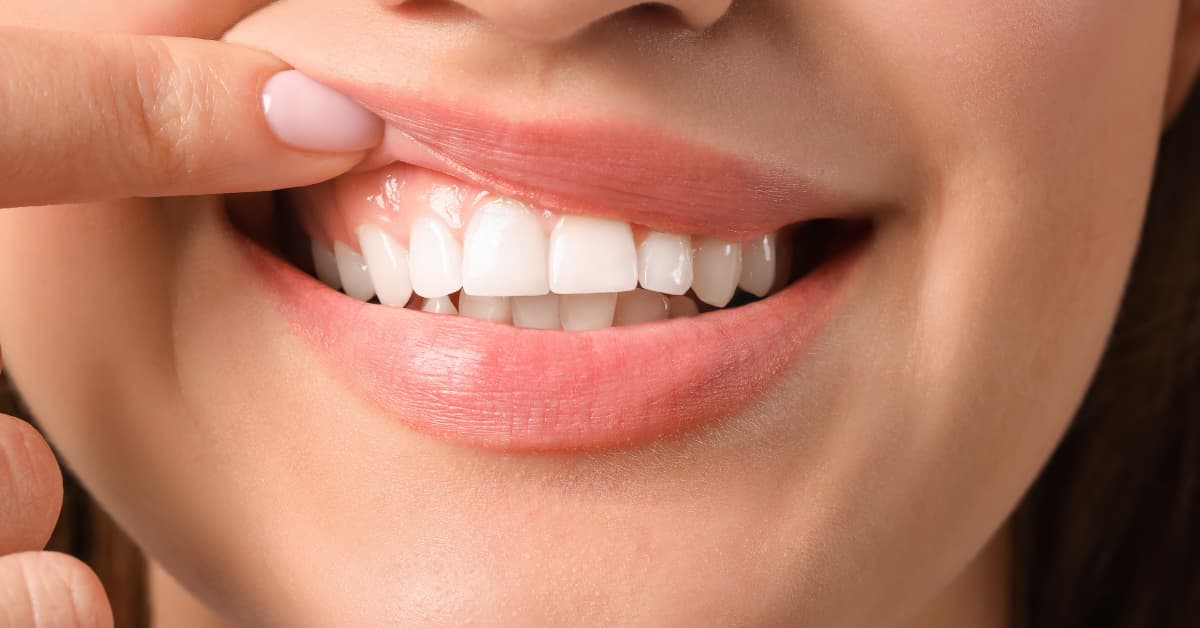How to Fix Receding Gums: The Ultimate Guide to Treatment & Restoration
Learning how to fix receding gums is crucial for the millions of adults worldwide who face this common yet concerning dental issue.
When gum tissue gradually pulls back from the teeth, it exposes the sensitive tooth roots, creating an environment ripe for pain, sensitivity, and potential tooth loss. Early intervention can mean the difference between simple preventive care and complex surgical intervention.
For residents seeking expert gum recession treatment, Comprehensive Dental Care stands out as a premier provider, offering both non-surgical and advanced surgical solutions tailored to each patient’s unique needs.
With state-of-the-art technology and a patient-focused approach, their experienced team helps restore healthy gums and protect your smile for years to come.
Key Takeaways:
- Early Detection Matters: Identifying receding gums early allows for less invasive treatments and better outcomes
- Multiple Treatment Options: From improved oral hygiene to surgical grafts, various approaches on how to fix receding gums effectively
- Prevention is Possible: Proper brushing techniques, regular dental visits, and lifestyle changes can prevent further recession
- Professional Care is Essential: Expert evaluation and treatment planning ensure the most appropriate approach for your specific condition
- Long-term Success: With proper care and professional guidance, receding gums can be successfully treated and managed
Understanding How to Fix Receding Gums: What Are They?
Receding gums occur when the gum tissue that surrounds and protects your teeth gradually wears away or pulls back, exposing more of the tooth or its root. This condition doesn’t happen overnight but develops slowly, often going unnoticed until symptoms become apparent.
The most common signs include teeth that appear longer than normal, increased sensitivity to hot and cold temperatures, and visible notches near the gum line.
You might also notice changes in how your teeth feel when you brush or experience discomfort when consuming acidic foods or beverages.
Healthy gum tissue acts as a protective barrier, shielding the sensitive tooth roots from bacteria, temperature extremes, and physical damage. When gums recede, this protection disappears, leaving the underlying tooth structure vulnerable to decay, sensitivity, and eventual tooth loss if left untreated.
The Root Causes Behind Receding Gums: Why This Happens
Understanding the underlying causes of gum recession is crucial for determining how to fix receding gums effectively. Several factors contribute to this condition, often working in combination to accelerate tissue loss.
Aggressive Brushing and Poor Oral Hygiene
Many people unknowingly damage their gums through overzealous brushing with hard-bristled toothbrushes or using excessive pressure during their oral care routine.
This mechanical trauma gradually wears away delicate gum tissue. Conversely, inadequate oral hygiene allows plaque and tartar buildup, leading to inflammation and eventual tissue destruction.
Periodontal Disease and Bacterial Infection
Gum disease represents the leading cause of gum recession, as bacterial infections destroy the tissues and bones that support your teeth. This progressive condition starts with gingivitis and can advance to severe periodontitis if not properly treated.
Lifestyle Factors and Genetic Predisposition
Smoking and tobacco use significantly restrict blood flow to gum tissues, impairing healing and accelerating recession. Hormonal changes, particularly in women during pregnancy or menopause, can make gums more sensitive and prone to recession.
Additionally, some individuals inherit thinner gum tissue, making them naturally more susceptible to recession regardless of their oral care habits.
Non-Surgical Approaches: How to Fix Receding Gums Without Surgery
For patients in the early stages of gum recession, several non-surgical treatments can effectively halt progression and improve gum health. These conservative approaches often provide excellent results when implemented promptly and consistently.
Improving Your Daily Oral Care Routine
The foundation on how to fix receding gums begins with optimizing your home care routine. Switching to a soft-bristled toothbrush and using gentle, circular motions instead of aggressive scrubbing can prevent further damage.
Proper flossing techniques help remove plaque from areas where toothbrushes can’t reach, particularly along the gum line, where recession often begins.
Professional Deep Cleaning Treatments
Scaling and root planing, often called deep cleaning, represents one of the most effective non-surgical treatments for addressing receding gums caused by periodontal disease.
This procedure involves removing plaque and tartar deposits from below the gum line and smoothing rough root surfaces to encourage healthy tissue reattachment.
During this treatment, your dental professional will carefully clean the infected areas and may apply antimicrobial agents to eliminate harmful bacteria. Many patients experience significant improvement in gum health following this procedure, with reduced inflammation and halted recession progression.
Advanced Laser Therapy
Modern laser technology offers a minimally invasive approach to treating gum recession by targeting diseased tissue and bacteria while promoting healthy tissue regeneration. This comfortable procedure often requires less recovery time than traditional methods while providing excellent results for appropriate candidates.
Surgical Solutions: Advanced Options on How to Fix Receding Gums
When non-surgical treatments aren’t sufficient, or the recession has progressed significantly, surgical intervention becomes necessary to restore proper gum coverage and protect exposed tooth roots.
Gum Graft Surgery: The Gold Standard
Gum grafting remains the most predictable and effective surgical method for fixing receding gums. During this procedure, tissue is taken from another area of your mouth (typically the palate) or from a donor source and surgically placed over the exposed root surfaces.
Three main types of grafts address different needs: connective tissue grafts provide the most versatile solution for covering exposed roots, free gingival grafts increase the amount of keratinized tissue, and pedicle grafts use nearby tissue when adequate gum tissue exists adjacent to the recession site.
Innovative Pinhole Surgical Technique
This revolutionary approach offers a less invasive alternative to traditional grafting by using small incisions to reposition existing gum tissue over exposed roots. The procedure requires no sutures and typically involves minimal discomfort and faster healing compared to conventional surgery.
Regenerative Procedures for Severe Cases
In cases where both gum tissue and the underlying bone have been lost, regenerative techniques may be employed alongside grafting procedures. These advanced treatments use growth factors and specialized materials to encourage the regeneration of lost tissues and bone support.
Natural Remedies and Lifestyle Changes to Support Gum Health
While professional treatment remains essential for fixing receding gums, several natural approaches can support your healing process and improve overall gum health when used alongside professional care.
Beneficial Natural Remedies and Lifestyle Adjustments:
- Oil pulling: Swishing coconut or sesame oil in your mouth for 10-15 minutes daily can reduce harmful bacteria and inflammation, though it should never replace proper brushing and flossing
- Anti-inflammatory nutrition: Foods rich in vitamin C, omega-3 fatty acids, and antioxidants support tissue healing and overall oral health
- Green tea consumption: Regular intake provides powerful antioxidants that may help reduce gum inflammation
- Stress management techniques: Chronic stress contributes to teeth grinding and clenching, which can accelerate gum recession
- Nightguard protection: Using a custom nightguard helps protect your gums from additional trauma if you grind your teeth
- Tobacco cessation: Quitting smoking dramatically improves oral healing and blood flow to gum tissues
These complementary approaches work best when combined with professional dental care and consistent oral hygiene practices at home.
Prevention: Your Best Defense Against Receding Gums
Preventing gum recession is significantly easier and less costly than treating advanced cases. Regular dental visits every six months allow for early detection and intervention before the recession becomes severe.
Essential Prevention Strategies:
- Bi-annual dental visits: Schedule routine check-ups every six months for early detection and professional intervention
- Professional cleanings: Remove tartar buildup that daily brushing cannot eliminate
- Proper brushing technique: Use soft-bristled toothbrushes with gentle, circular motions instead of aggressive scrubbing
- Daily flossing: Maintain consistent flossing to prevent plaque accumulation along the gum line
- Tobacco avoidance: Eliminate smoking and tobacco use to improve blood flow and tissue health
- Risk factor management: Address family history of gum disease, hormonal changes, or other predisposing factors
- Custom nightguards: Protect against teeth grinding and clenching that can contribute to recession
Your dental team can provide personalized recommendations for your specific needs and risk factors. If you have elevated risk factors, such as a family history of gum disease or hormonal changes, more frequent dental visits may be recommended to maintain optimal gum health.
Addressing Common Concerns: Cost and Comfort Considerations
Many patients delay seeking treatment for receding gums due to concerns about cost or fear of surgical procedures. However, early intervention with non-surgical treatments is typically more affordable and comfortable than waiting until surgery becomes necessary.
Most dental insurance plans provide coverage for periodontal treatments, and many dental offices offer flexible payment plans to make care more accessible.
The cost of treating early-stage recession is minimal compared to the expense and complexity of addressing advanced cases that may require multiple surgical procedures or even tooth replacement.
How Comprehensive Dental Care Fixes Receding Gums
Comprehensive Dental Care excels in providing personalized treatment plans for patients with receding gums, combining advanced diagnostic technology with experienced clinical expertise.
Their state-of-the-art facility offers both non-surgical and surgical treatment options, ensuring that each patient receives the most appropriate care for their specific condition.
The practice’s skilled professionals begin with a thorough evaluation using digital imaging and comprehensive periodontal assessments to determine the extent of the recession and identify contributing factors. This detailed approach allows them to create customized treatment plans that address both immediate needs and long-term gum health.
What sets Comprehensive Dental Care apart is its commitment to patient education and prevention. They work closely with each patient to develop personalized home care routines and provide ongoing support to maintain healthy gums long after treatment completion.
Their comfortable environment and modern techniques help ensure that even surgical procedures are as comfortable as possible.
FAQs About How to Fix Receding Gums
Can receding gums grow back naturally?
Unfortunately, receding gums cannot regenerate naturally once the tissue has been lost. However, early intervention can halt further recession and protect the remaining gum tissue. Surgical procedures like gum grafts can restore coverage over exposed root surfaces, effectively “growing back” gum tissue through transplantation.
How long does it take to fix receding gums?
The timeline varies depending on the treatment approach. Non-surgical treatments like deep cleaning show improvement within 2-4 weeks, while complete healing may take several months. Surgical procedures typically require 6-8 weeks for initial healing, with full results visible after 3-6 months.
Is fixing receding gums painful?
Modern treatment techniques prioritize patient comfort. Non-surgical treatments involve minimal discomfort, while surgical procedures are performed under local anesthesia. Post-treatment discomfort is typically manageable with over-the-counter pain medications and prescribed pain relievers when necessary.
How much does it cost to fix receding gums?
Treatment costs vary based on the severity of the recession and the chosen treatment method. Non-surgical deep cleaning typically ranges from $200-$800 per quadrant, while surgical grafting may cost $600-$3,000 per area treated. Most dental insurance plans provide partial coverage for these medically necessary procedures.
Take Action: Fix Your Receding Gums Today
Receding gums won’t improve on their own and typically worsen without professional intervention. The earlier you address gum recession, the more treatment options are available, and the better your long-term prognosis becomes.
Don’t let receding gums compromise your oral health or confidence. Modern treatments offer effective solutions for every stage of gum recession, from simple preventive measures to advanced surgical restoration.
Ready to protect your smile and restore your gum health? Contact Comprehensive Dental Care today to schedule a comprehensive evaluation and discover how their expert team can fix your receding gums with personalized, comfortable care!



